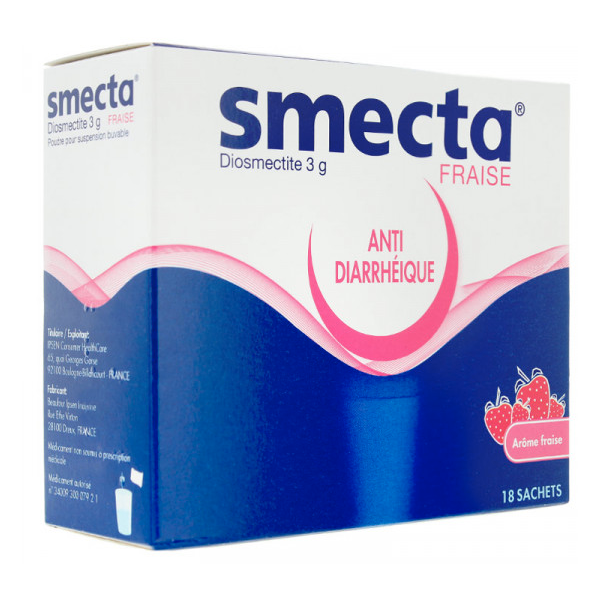1. NAME OF DRUG SMECTA 3G STRAWBERRY powder sachet to drink.
2. QUALITATIVE AND QUANTITATIVE COMPOSITION
Diosmectite: 3.00 g Per sachet.
Dilutants with noticeable effect: glucose. To see a complete list of dilutants, see section 6.1.
3. PHARMACEUTICAL FORM Sachet. Sachet with powder for a drinkable solution.
4. CLINICAL DATA
4.1. Therapeutic Indications Symptomatic treatment for acute diarrhoea for children and newborns alongside an oral rehydration. Symptomatic treatment for chronic diarrhoea. Symptomatic treatment for pain linked to the stomach and oesogastroduodenum.
4.2. Dosage and how to use Treatment for acute diarrhoea: Baby and child: Before 1 year: 2 sachets per day for 3 days then 1 sachet per day. Older than 1 year: 4 sachets per day for 3 days then 2 sachets per day. Adults: 3 sachets per day. The daily dose can be doubled at the beginning of treatment. Other indications: Baby and child: Before 1 year: 1 sachet per day. Between 1-2 years: 1-2 sachets per day. Children > 2 years: 2-3 sachets per day. For adults: 3 sachets per day. How to use: The contents of the sachet have to be suspended before taking. Taking the sachet: - after meals in the oesophagus - outside meal times for other indications. Baby and Children The contents of the sachet can be put in a 50ml feeding bottle and mixed with another liquid substance: compote, purée, yoghurt... Use for adults The contents of the sachet can be put into half a glass of water.
4.3. Contraindications Over-sensitivity to diosmectite or one of its dilutants.
4.4. Special warnings and side effects Diosmectite should be used with caution in patients with a history of severe chronic constipation. In children, treatment of acute diarrhoea should be performed in combination with early oral rehydration (ORS) administration to avoid dehydration. In adults, treatment does not relieve rehydration if it is necessary. The importance of rehydration by oral rehydration or intravenous rehydration should be adjusted according to the intensity of the diarrhoea, the age and the particularities of the patient. Patients need to: - hydrate themselves with sweet or savoury drinks to compensate for the loss of liquid from diarrhoea (daily amount for adults is 2 litres). - keep-up food intake during diarrhoea. - avoid certain foods such as crudities, fruit, green vegetables, spicy dishes as well as xold drinks and food. - but eat grilled meat and rice. This drug contains glucose. This drug is not recommended for patients with a glucose or galactose malabsorption syndrome.
4.5. Interactions with other drugs Since the absorbent properties of this product may interfere with the delays and / or absorption rates of another substance, it is recommended to administer any other medication from SMECTA 3 g STRAWBERRY. 4.6. Pregnancy and breast feeding There is no clear evidence of malformations detected in animals. In clinical studies there are no particular malformative or foetotoxic effects appeared to date. However monitoring pregnancies exposed to this drug is not enough to rule out any risk. Given that SMECTA is not absorbed, it can be used during pregnancy if necessary.
4.7. Effects on the ability to drive and operate machinery Not applicable. 4.8. Side effects The following side effects have been reported during clinical studies on children and adults. These side effects were generally of minor and transient intensity and concerned mainly the digestive tract. The frequencies of side effects were classified as frequent (≥ 1/100,



